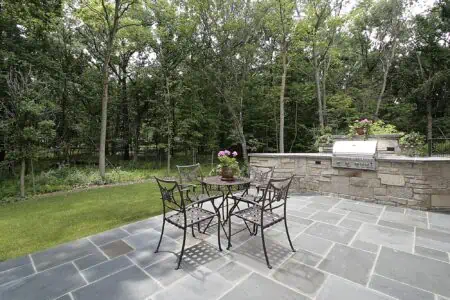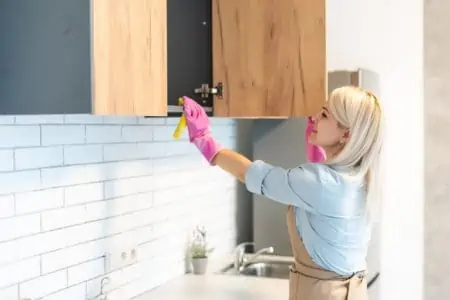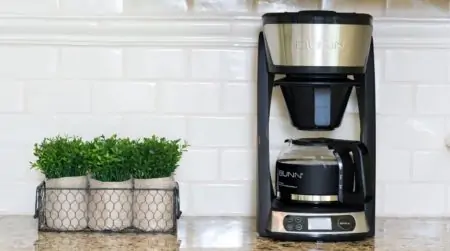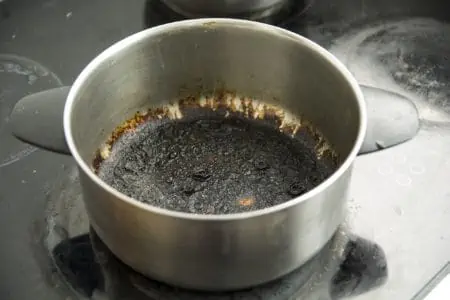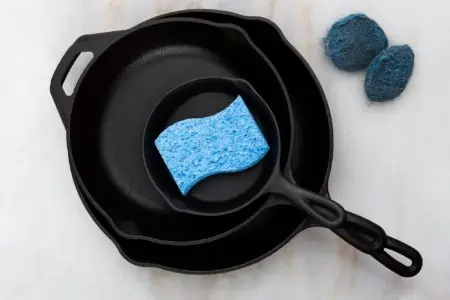Bluestone is a common stone used for pool decks, patios, walkways, or even table tops. This stunning landscaping choice can create a statement, but when it’s covered in stains, it looks dingy.
Are you wondering how to remove stains from bluestone? We’ll share four methods for removing general stains, plus tips on removing water stains, rust, and mildew.
Keep reading for the ultimate guide to keeping your bluestone beautiful.
Key Takeaways
- Remove general stains from bluestone using a mixture of ½ cup dish soap and one gallon of water, scrubbing in circular motions and rinsing with plain water.
- Use a 1:1 solution of distilled white vinegar and water for stubborn stains, applying the mixture with a scrubbing brush and rinsing with plain water.
- For organic and biological stains like algae and mildew, use a mixture of one liter of water per two teaspoons of ammonia, scrubbing the stone, and rinsing with plain water.
- Tackle rust stains with a rust remover safe for bluestone, following the manufacturer’s instructions, and rinse the cleaner away.
Does Bluestone Stain Easily?
Bluestone is naturally porous — it is not stain-resistant. However, it’s more stain-resistant than limestone, travertine, wood, or granite.
It’s essential that you seal bluestone pavers so the area is resistant to stains. Common stains on bluestone include water stains (from wet leaves, for example), rust, cooking oil, mildew, and even etching.
When sealing bluestone, repeat the process every six to 12 months. And don’t forget to seal the grout too!
How to Remove Stains From Bluestone
It’s time to learn the best way to clean bluestone stains. Avoid using harsh cleaners on bluestone, as this can cause damage. Our methods start with a gentle cleaning approach and gradually intensify for tougher stains.
With Soap and Water
You can remove stains on bluestone with dish soap and water. It’s excellent for various stains, including food and oil. That’s right — you don’t need a specialized bluestone cleaner.
- Sweep: Sweep the area to remove debris from the bluestone.
- Prepare cleaner: Mix ½ cup of dish soap and a gallon of water in a bucket. Stir to distribute the soap.
- Scrub the stone: Dip a broom or scrubbing brush into the mixture and apply it to the stain. Scrub the stain in circular motions. Dip the brush back into the mixture and reapply as necessary. You can scrub bluestone quite hard — so don’t be shy!
- Rinse: Once the stain has gone, refill the bucket with plain water. Dip your brush into the water and rinse the bluestone.
Try This Instead
If the stain is a bit more stubborn, you can use a pressure washer with a mild detergent. Don’t exceed 1500 PSI, as this could damage the stone.
With Vinegar
Vinegar can treat stubborn stains on bluestone. Using vinegar is very similar to the above method.
- Sweep: Sweep the area to remove debris from the bluestone.
- Prepare cleaner: In a bucket, mix a 1:1 solution of distilled white vinegar and water.
- Scrub the stone: Dip a broom or scrubbing brush into the mixture and apply it to the stain in circular motions. Keep reapplying and scrubbing as necessary.
- Rinse: Once the stain has gone, refill the bucket with plain water. Dip your brush into the water and rinse the bluestone.
With Ammonia
Have you got organic and biological stains you need to tackle? Use ammonia to remove algae, mildew, and moss stains from bluestone.
- Sweep: Always start by sweeping the area to remove debris.
- Prepare the cleaner: In a bucket, mix one liter of water per two teaspoons of ammonia. Increase the quantities as necessary. Use an old stick to stir the mixture together.
- Scrub: Use a scrubbing brush to apply the ammonia-water mixture to the stain. Leave it on for five minutes before scrubbing again.
- Rinse: Rinse the stone using plain water.
- If the stain persists: Mix two drops of ammonia with ½ cup of 12 percent hydrogen peroxide. Apply it to the stain and let it sit for five minutes before scrubbing. Rinse the area.
With Muriatic Acid
For super tough stains that aren’t budging with other methods, muriatic acid should be your last resort. We recommend avoiding it where possible. You should hire a professional stone cleaner before using this, as they will have safer methods that won’t damage your stone.
The problem with muriatic acid on stone is that it can cause oxidation and leave stains that are impossible to remove.
Here’s how to use muriatic acid for cleaning bluestone:
- Prepare the area: Once you’ve donned your protective gear, cover all plants and foliage. Have a source of water — like a garden hose — nearby to neutralize any spilled acid. Don’t do this job on a windy day, as the acid can spray around, causing damage.
- Sweep: Sweep the area, removing debris.
- Prepare the mixture: Pour 10 parts of water into a large container. Then carefully add one part of muriatic acid. Always add the water first, then the acid. If you do it the other way around, it can cause a heated chemical reaction. Don’t overdo the amounts — one tablespoon of acid per 10 tablespoons of water is fine to start.
- Brush the stain: Dip a long-handled brush into the mixture and apply it to the stain. Leave it to sit for two or three minutes maximum before scrubbing the area.
- Rinse and scrub: Once the stain has been lifted, rinse and scrub the area simultaneously to remove the stain and the acid.
- Neutralize: Cover the area with baking soda to neutralize the acid.
- Rinse: Rinse the area again.
Now you must dispose of the unused muriatic acid. You can’t just pour it down the drain, so you must find another way to get rid of it.
One option is to use the leftovers to clean your concrete. Another option is to recycle it with your council — check if they have the equipment to recycle hazardous chemicals.
Finally, you can neutralize the excess acid before getting rid of it:
- Use lime: Add three to four cups of lime juice to the bottom of a container.
- Add the acid: Wearing your respiratory mask, slowly add the leftover acid to the lime juice.
- Stir: Using an old stick, stir the mixture until the fizzing has stopped.
- Remove: You can safely pour the mixture down your sink or storm drain.
Danger
Muriatic acid is toxic to inhale (1). If you decide to use it, make sure you work in a well-ventilated area, and wear protective gloves, eyewear, and a respiratory mask.
How to Remove Water Stains From Bluestone
Hard water can leave behind mineral deposits on bluestone. These unsightly stains can be difficult to remove, especially if you continue to clean them with hard water!
Here’s a handy method to try:
- Sweep: Sweep debris away from the area.
- Apply baking soda: Apply a generous amount of baking soda to the stains and leave it on for a couple of hours.
- Apply vinegar: Apply distilled white vinegar to the baking soda. It will fizz up, but this is normal.
- Scrub: Scrub the stains well, moving in circular motions.
- Rinse: Rinse the area with distilled or purified water. If possible, get a filter on your garden hose or pressure washer, so you aren’t regularly applying hard water to the bluestone.
Removing Rust Stains From Bluestone
Rust stains can be a sight for sore eyes. But we have a great method for removing rust stains from bluestone. You will need a rust remover or poultice that’s safe for bluestone, such as the Singerman Laboratories Rust Remover.
- Prepare the area: Sweep debris from the area and wear protective gloves if necessary. Always read the manufacturer’s advice.
- Prepare the cleaner: According to the packaging instructions, dilute the cleaner.
- Apply the cleaner: Spread the mixture over the stain using a large utensil, such as a spoon or spatula.
- Wait: Leave the cleaner on the rust stain for the recommended amount of time.
- Rinse: Use a garden hose or pressure washer to rinse the cleaner away.
- Repeat: Repeat the above steps if necessary.
Warning
Always test your cleaner in an inconspicuous area of the bluestone first. You want to ensure it doesn’t cause any damage.
How to Remove Mildew From Bluestone
Mold, mildew, and algae can leave behind nasty black spots on bluestone. To remove them, we have to call in the big guns. For this, you’ll either use bleach or hydrogen peroxide. We prefer hydrogen peroxide as it’s less toxic.
Caution
Never mix hydrogen peroxide with bleach, as this can cause toxic gas.
- Sweep: Sweep debris away from the area.
- Prepare your cleaner: Mix ½ cup of hydrogen peroxide per one gallon of water.
- Apply: Apply the cleaner to the stain using a mop or scrubbing brush. Let it sit for two minutes.
- Scrub: Scrub the area with a bristled brush until the stains have lifted.
- Rinse: Rinse the area with a garden hose.
- Repeat: Repeat if necessary.
- Extra step: To remove water, use a wet vacuum. This can eliminate the excess moisture, cutting down on mold and mildew regrowth.
Tips For Bluestone Maintenance
The best way to clean bluestone stains is to prevent them in the first place. We’ll share some handy hacks for maintaining your bluestone, so it lasts for ages and won’t stain as much.
- Power wash every few years: Between spot-cleaning, power wash the surface every one to two years. This can remove debris, dirt, and stains. You might want to hire a professional to avoid damage.
- Sweep and mop regularly: Sweep your bluestone surface weekly to remove debris. Mop it once or twice a month with soapy water to prevent stains.
- Avoid harsh chemicals: For regular cleaning, opt for soap or vinegar. Avoid harsh chemicals often, as this can damage the stone.
- Sealing often: Reseal the bluestone every six to 12 months. This will prevent stains from forming. A popular option is Dominator Stone+ Gloss Sealer.
- Tackle spills right away: When someone spills something on the bluestone, clean it up right away. Immediate action can prevent spills from turning into stains. This works for all kinds of spills, including food, wood stain, hard water stains, and more.
- Keep the plants away: Leaving plants on or near your bluestone can quickly cause stains. When wet leaves fall on the stone or moisture accumulates underneath plant pots, you’re left with some sticky stains.
FAQs
Blasting Away Bluestone Stains
Removing stains from bluestone is straightforward, especially when dealing with fresh stains. It’s vital that you tackle stains immediately to avoid them settling into the stone forever.
There are many ways to clean stains from bluestone. You can use soap and water, vinegar, ammonia, baking soda, and hydrogen peroxide. Muriatic acid also works, but we recommend using this as a last resort.
Always remember to wear protective gear when dealing with harsh chemicals. Keep plants and pets away for their safety.
